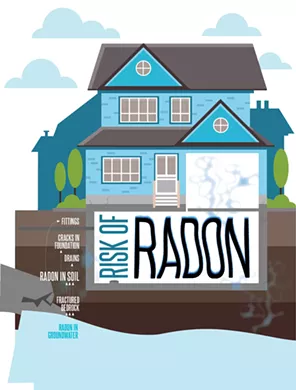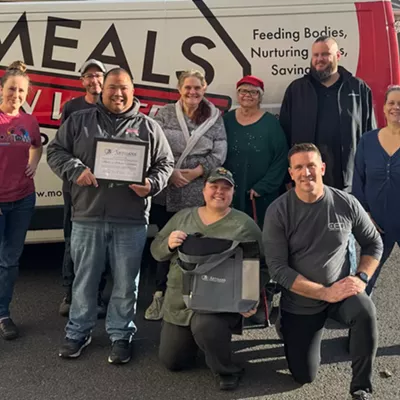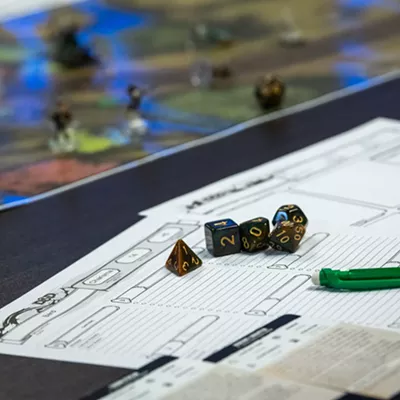Something toxic lingers in the air I breathe at home. Radon gas could be seeping into your home, too.
Ironically, I first learned about the risk of radon gas in indoor environments whilst researching a story about the Hanford Nuclear Reservation. As it turns out, in regions rich in uranium deposits, like the Spokane-Coeur d'Alene area, radon gas inside homes, schools and workplaces is an often overlooked — but potentially serious — health concern.
Radon is a naturally occurring radioactive gas created from the decay of uranium in the ground. The gas seeps up through the soil and can enter buildings through cracks in foundations and walls and around pipes entering the home. (It can also enter through the water supply.) Once trapped inside, radon can build up. Homes in any area, of any age, or any construction design can be impacted by radon.
According to U.S. Environmental Protection Agency estimates, radon is the top cause of lung cancer in nonsmokers and the second overall leading cause behind smoking. Estimates are that around 21,000 people per year die of radon-caused lung cancer.
These statistics — paired with the Inland Northwest's unique geological makeup — mean testing your own home for radon shouldn't be brushed aside. Testing for radon is part of most inspections when buying and selling a home, but experts still recommend doing so every few years to check for changes or seasonal fluctuations. There are no state-level requirements, however, for radon testing or mitigation in rental properties.
Thankfully, testing is easy and inexpensive. Costs do rise, however, if your home's results require mitigation.
When I first learned last fall about high radon levels in the Inland Northwest, I bought a $15 test kit online (First Alert brand), and carefully followed the instructions. The short-term test was easy to use, and after three days sitting in the basement of our 1948 home in Spokane's North Hill neighborhood, I sent it off to a lab for testing, included with the purchase. The results returned by email about a week later. By a very slight amount, there was too much radon in the house: 4.2 picocuries per liter.
A picocurie (pCi) is a measurement of radioactive decay. The EPA guidelines for indoor radon gas levels are set at a maximum of 4 pCi per liter of air. The World Health Organization, meanwhile, sets this limit at 2.7 pCi/L.
Since our test came back just slightly above the U.S. maximum allowance, the next step is a long-term test, measuring for three months to a year, to confirm our initial result. The second test device, about the size and shape of a hockey puck, is now sitting near the washing machine, slowly collecting evidence. We won't send it back for testing for another few months, but each time I head downstairs to do laundry and see it sitting there, I can't help but wonder if I'm breathing in something deadly.
Finding it slightly alarming that I hadn't heard or seen anything until recently about radon gas risks in our region, I contacted the Spokane Regional Health District to talk to an expert about recommended steps of action for awareness and mitigation.
Environmental health specialist Michael LaScuola, who's been with the Health District since the late '80s, says public awareness campaigns about radon were active at that time and into the '90s, but have since been deeply affected by funding cuts.
Back then, he says, "we were fortunate enough to get some pretty good grants to support a radon test kit program, selling them at cost and gathering data and plotting where we could see it."
While the Health District no longer sells these kits directly to residents, staff continue to consult with concerned locals who reach out, directing them to resources and information about radon, he adds.
"Anybody in Spokane should test their home. That is a given," LaScuola says. "You can't tell if you have elevated radon unless you test."
Based on results he's seen over the years, LaScuola says pockets of the region that tend to have higher radon readings are Spokane Valley, the foothills of Mount Spokane and the High Drive bluff of south Spokane.
How does radon impact health?
Prolonged exposure to environments with high levels of radon is linked to an increased risk of lung cancer. When inhaled, these radioactive particles enter the lungs and can damage cells.
When should I test?
Testing is best done during cooler months, between November and March, when windows and doors are closed.
How do I know my kids' school is safe?
Health District expert LaScuola says when radon concerns arose in the late '80s and early '90s, local schools were tested and mitigated where necessary.
Where can I find out more?
Head to the EPA's website: epa.gov/radon.
"Radon is naturally occurring, so I think sometimes people get complacent about naturally occurring hazards, as opposed to others like groundwater contamination," LaScuola says. "But because radon begins with uranium, we're also seeing it in groundwater in the northeast part of Spokane County, and beginning to encourage people to test private wells."
In Idaho, the Coeur d'Alene area has the state's highest percentage, at 62 percent, of high-radon testing homes. Idaho residents can order $10 test kits directly through the Idaho Department of Health & Welfare, at radonidaho.org.
Even in areas known for having high radon levels, the gas's presence from house to house in the same neighborhood can vary drastically, LaScuola notes.
He points out a map of Spokane County visualizing historical radon test data. Green dots indicate homes shown to be under 4 pCi/L. Yellow and orange dots are places that tested between 4 and 20 pCi/L, while red dots — homes that tested at greater than 20 pCi/L — show up both in apparent clusters and mixed in across the map right next to green and yellow dots.
If you test your home and find out there's too much radon present, what next?
LaScuola says you'll want to consider installing a radon mitigation system, which uses a fan to push air rising beneath the home through an outside vent. These systems can cost between $900 and $3,500, depending on how much radon is present and the age and size of the home. Homes built after 1992 in Washington state, however, are required to have some mitigation infrastructure built in that can be easily activated in case radon is found to be high, he says.
For our home, hopefully the long-term test shows the average radon level is such that we don't need to take this next step. If it doesn't, though, we'll definitely use our newfound knowledge to take a proactive step.
"If you're concerned about health wellness and long-term health maintenance, you should really look into radon," LaScuola emphasizes. "Granted, there are so many other things you should do to maintain your health, but this should be right up there."





















